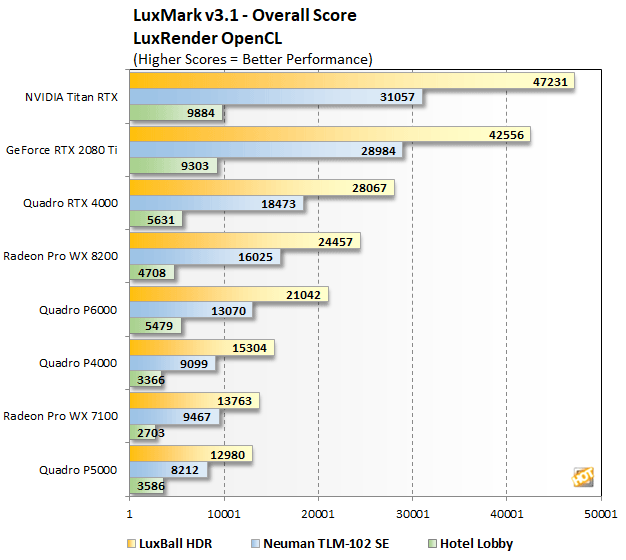LuxMark is a cross-platform,
OpenCL-accelerated 3D rendering benchmark. It's a tool based on the open source LuxRender physically-based spectral rendering engine, which accurately models the transportation of light and supports high dynamic range. LuxRender features a number of material types to allow rendering of photo-realistic and artistic scenes. LuxRender is free software, licensed under the GPL, that offers plugins for packages like Blender, Maya, Cinema 4D and 3DS Max.
 |
|
LuxMark v3.1 |
|
OpenCL Benchmark |
|
The Quadro RTX 4000 performed particular well in all three of LuxMark's workloads. In these tests, the Turing-based RX 4000 outpaces all of the Pascal-based Quadros -- including the
beastly P6000 -- and trails only the ultra-high-end Turing GPUs.
 |
|
V-Ray Benchmark |
|
GPU Rendering Performance |
|
The V-Ray Benchmark offers both CPU and GPU rendering modes. Previous versions leveraged
NVIDIA CUDA, but the latest edition of the benchmark uses CUDA or OpenCL on GPUs and is compatible with Windows, MacOS, and Linux.
The Quadro RTX 4000 nearly catches the Quadro P6000 in the V-Ray benchmark and blows past the
Radeon Pro WX-series cards and the P4000 / P5000.
 |
|
Cinebench R15 |
|
OpenGL Benchmark |
|
Cinebench R15’s OpenGL benchmark uses a complex 3D scene depicting a car chase (created by renderbaron) to measure a GPU’s performance. The benchmark employs a large amount of geometry (nearly 1 million polygons) and textures, and features a variety of effects, such as bump maps, transparency, and complex lighting. Scores in this test are reported in frames per second...
Due to its age, Cinebench's OpenGL benchmarks is a relatively light-duty test that doesn't heavily tax today's pro graphics. Even still, the Quadro RTX 4000 nearly catches the P6000 once again, and outpaces its other predecessors across the board.











